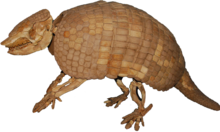Pampatheriidae
You can help expand this article with text translated from the corresponding article in German. (June 2022) Click [show] for important translation instructions.
|
| Pampatheriidae Temporal range: | |
|---|---|
 | |
| Holmesina occidentalis | |
| Scientific classification | |
| Domain: | Eukaryota |
| Kingdom: | Animalia |
| Phylum: | Chordata |
| Class: | Mammalia |
| Order: | Cingulata |
| Family: | †Pampatheriidae Paula Couto 1954 |
| Genera | |
Pampatheriidae ("Pampas beasts") is an extinct family of large cingulates related to armadillos. They first appeared in South America during the mid-Miocene, and Holmesina and Pampatherium spread to North America during the Pleistocene after the formation of the Isthmus of Panama as part of the Great American Interchange. They became extinct as part of the end-Pleistocene extinction event, about 12,000 years ago.[2]
Taxonomy
[edit]The placement of the Eocene genus Machlydotherium in the family is considered doubtful. The oldest undoubted member of the group is Scirrotherium from La Venta, Colombia, dating to the mid-Miocene.[2] Analyis of ear morphology suggests that they are most closely related to the much larger glyptodonts, which genetic evidence indicates is nested with modern armadillos as part of the family Chlamyphoridae, which by extension also places pampatheres within this group.[3]
Phylogeny after Tambusso et al. (2021):[4]
| Cingulata |
| |||||||||||||||||||||||||||
Description
[edit]Pampatheres are believed to have attained a weight of up to 200 kg (440 lb). Like three-banded armadillos, and unlike glyptodonts, their armored shell was given some flexibility by three movable lateral bands of scutes.[5] The osteoderms (bony plates in the skin comprising the armor) of pampatheres were each covered by a single keratinized scute, unlike osteoderms of armadillos, which have more than one scute.[5]

A study of pampathere jaw biomechanics showed that their masticatory musculature was more powerful and more adapted for transverse movements than that of armadillos, leading to the conclusion that much of their diet was coarse vegetation. They are thought to have been primarily grazers, unlike armadillos, which are omnivorous or insectivorous.[5] The variation between species in the expression of adaptations for grinding coarse vegetation correlates with the aridity of their habitat; such adaptations are most pronounced in Pampatherium typum, which lived in the arid Pampas, and least pronounced in Holmesina occidentalis, which lived in humid lowlands.[6]
Distribution
[edit]Pampatheres were widely distributed across South America during the Pleistocene ranging from northern Argentina, eastwards to northeastern Brazil, and westwards to Colombia and Peru.[7] As part of the Great American Interchange, pampatheres dispersed northwards into Central and North America, with members of the genus Holmesina reaching the United States, as far north as as Kansas, and as far east as Florida and South Carolina.[8]
References
[edit]- ^ Flávio Góis; Laureano Raúl González Ruiz; Gustavo Juan Scillato-Yané; Esteban Soibelzon (2015). "A Peculiar New Pampatheriidae (Mammalia: Xenarthra: Cingulata) from the Pleistocene of Argentina and Comments on Pampatheriidae Diversity". PLOS ONE. 10 (6): e0128296. Bibcode:2015PLoSO..1028296G. doi:10.1371/journal.pone.0128296. PMC 4470999. PMID 26083486.
- ^ a b Góis, Flávio; Scillato-Yané, Gustavo Juan; Carlini, Alfredo Armando; Guilherme, Edson (June 2013). "A new species of Scirrotherium Edmund & Theodor, 1997 (Xenarthra, Cingulata, Pampatheriidae) from the late Miocene of South America". Alcheringa: An Australasian Journal of Palaeontology. 37 (2): 177–188. Bibcode:2013Alch...37..177G. doi:10.1080/03115518.2013.733510. hdl:11336/18791. ISSN 0311-5518. S2CID 129039539.
- ^ Asakura, Yumi; Oliveira, é. V. (2024-07-02). "Histovariability of cingulate osteoderms from Brazilian Pleistocene". PalZ. Bibcode:2024PalZ..tmp...21A. doi:10.1007/s12542-024-00695-9. ISSN 0031-0220.
{{cite journal}}: CS1 maint: bibcode (link) - ^ Tambusso, P. Sebastián; Varela, Luciano; Góis, Flávio; Moura, Jorge Felipe; Villa, Chiara; Fariña, Richard A. (June 2021). "The inner ear anatomy of glyptodonts and pampatheres (Xenarthra, Cingulata): Functional and phylogenetic implications". Journal of South American Earth Sciences. 108: 103189. Bibcode:2021JSAES.10803189T. doi:10.1016/j.jsames.2021.103189. S2CID 234062118.
- ^ a b c Vizcaíno, S. F.; De Iuliis, G.; Bargo, M. S. (1998). "Skull Shape, Masticatory Apparatus, and Diet of Vassallia and Holmesina (Mammalia: Xenarthra: Pampatheriidae): When Anatomy Constrains Destiny". Journal of Mammalian Evolution. 5 (4): 291–322. doi:10.1023/A:1020500127041. S2CID 20186439.
- ^ De Iuliis, G.; Bargo, M. S.; Vizcaíno, S. F. (December 2000). "Variation in skull morphology and mastication in the fossil giant armadillo Pampatherium spp. and allied genera (Mammalia: Xenarthra: Pampatheriidae), with comments on their systematics and distribution". Journal of Vertebrate Paleontology. 20 (4): 743–754. doi:10.1671/0272-4634(2000)020[0743:VISMAM]2.0.CO;2. S2CID 86263866.
- ^ Scillato-Yané, G.J.; Carlini, A.A.; Tonni, E.P.; Noriega, J.I. (October 2005). "Paleobiogeography of the late Pleistocene pampatheres of South America". Journal of South American Earth Sciences. 20 (1–2): 131–138. Bibcode:2005JSAES..20..131S. doi:10.1016/j.jsames.2005.06.012. hdl:11336/80762.
- ^ Edmund, A . Gordon (1996-12-31), "A review of Pleistocene giant armadillos (Mammalia, Xenarthra, Pampatheriidae)", Palaeoecology and Palaeoenvironments of Late Cenozoic Mammals, University of Toronto Press, pp. 300–321, doi:10.3138/9781487574154-016, ISBN 978-1-4875-7415-4, retrieved 2024-08-26
External links
[edit]


 French
French Deutsch
Deutsch

